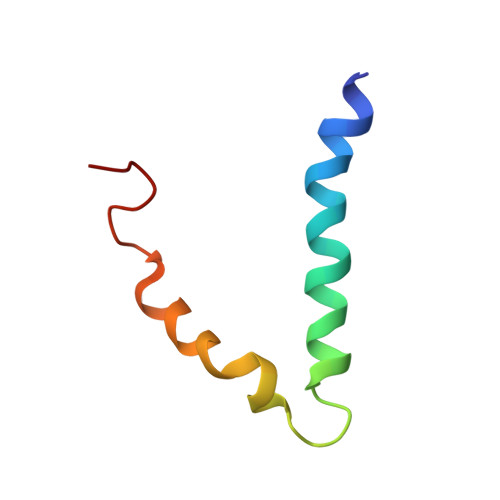NMR Structure of the FIV gp36 C-Terminal Heptad Repeat and Membrane-Proximal External Region.
Grimaldi, M., Buonocore, M., Scrima, M., Stillitano, I., D'Errico, G., Santoro, A., Amodio, G., Eletto, D., Gloria, A., Russo, T., Moltedo, O., Remondelli, P., Tosco, A., Wienk, H.L.J., D'Ursi, A.M.(2020) Int J Mol Sci 21
- PubMed: 32188158
- DOI: https://doi.org/10.3390/ijms21062037
- Primary Citation of Related Structures:
6FTK - PubMed Abstract:
Feline immunodeficiency virus (FIV), a lentivirus causing an immunodeficiency syndrome in cats, represents a relevant model of pre-screening therapies for human immunodeficiency virus (HIV). The envelope glycoproteins gp36 in FIV and gp41 in HIV mediate the fusion of the virus with the host cell membrane. They have a common structural framework in the C-terminal region that includes a Trp-rich membrane-proximal external region (MPER) and a C-terminal heptad repeat (CHR). MPER is essential for the correct positioning of gp36 on the lipid membrane, whereas CHR is essential for the stabilization of the low-energy six-helical bundle (6HB) that is necessary for the fusion of the virus envelope with the cell membrane. Conformational data for gp36 are missing, and several aspects of the MPER structure of different lentiviruses are still debated. In the present work, we report the structural investigation of a gp36 construct that includes the MPER and part of the CHR domain ( 737-786 gp36 CHR-MPER). Using 2D and 3D homo and heteronuclear NMR spectra on 15 N and 13 C double-labelled samples, we solved the NMR structure in micelles composed of dodecyl phosphocholine (DPC) and sodium dodecyl sulfate (SDS) 90/10 M: M. The structure of 737-786 gp36 CHR-MPER is characterized by a helix-turn-helix motif, with a regular α-helix and a moderately flexible 3 10 helix, characterizing the CHR and the MPER domains, respectively. The two helices are linked by a flexible loop regulating their orientation at a ~43° angle. We investigated the positioning of 737-786 gp36 CHR-MPER on the lipid membrane using spin label-enhanced NMR and ESR spectroscopies. On a different scale, using confocal microscopy imaging, we studied the effect of 737-786 gp36 CHR-MPER on 1,2-dioleoyl-sn-glycero-3-phosphocholine/1,2-dioleoyl-sn-glycero-3-phospho-(1'-rac-glycerol) (DOPC/DOPG) multilamellar vesicles (MLVs). This effect results in membrane budding and tubulation that is reminiscent of a membrane-plasticizing role that is typical of MPER domains during the event in which the virus envelope merges with the host cell membrane.
Organizational Affiliation:
Department of Pharmacy, University of Salerno, Via Giovanni Paolo II, 134, I-84084 Fisciano, Italy.














